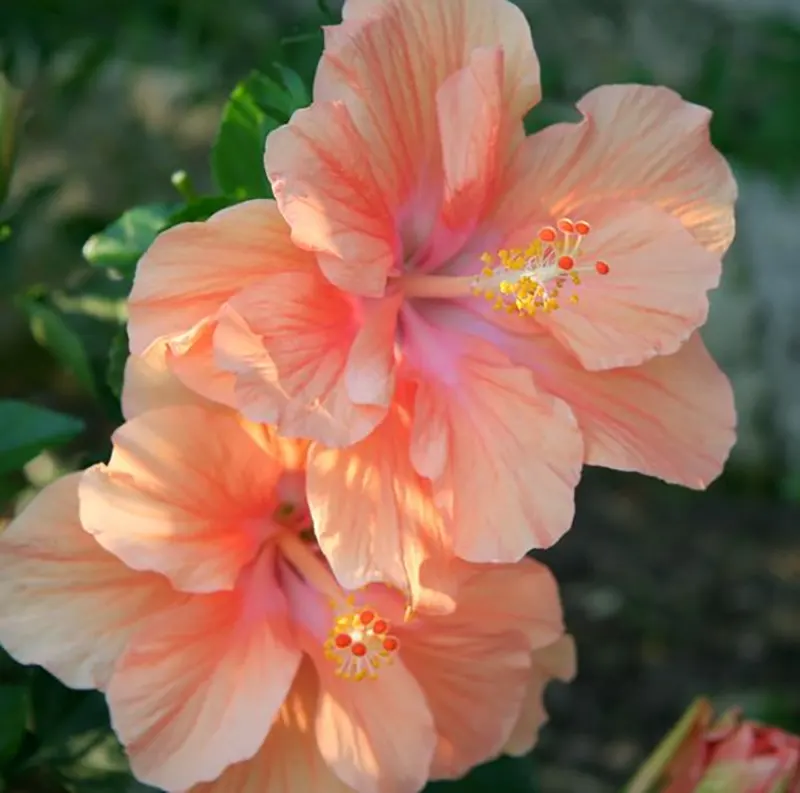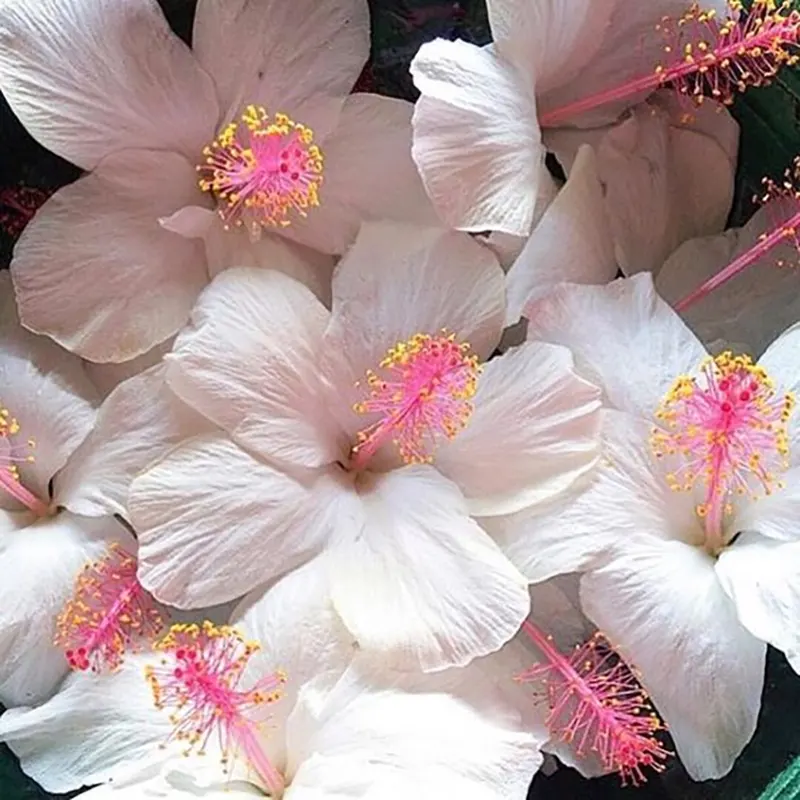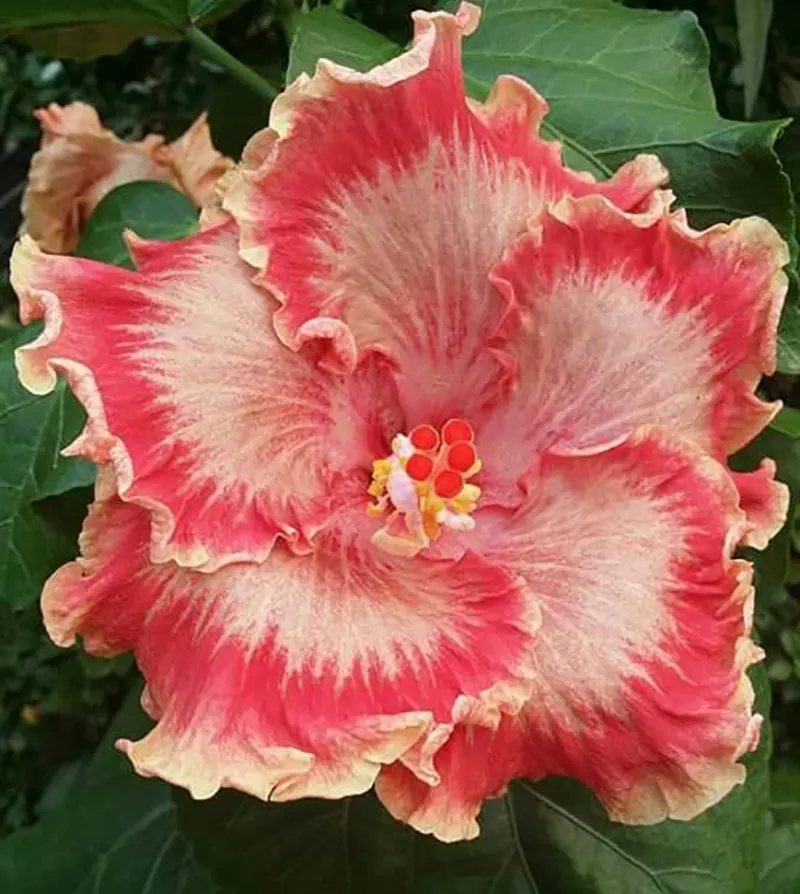5 Dynamite Uses for Hibiscus
Hibiscus is one of the most beautiful genera of flowering plants on the planet, Its usage as a symbol of importance by so many tribes and peoples the world over is proof of that. But, did you also know that it’s one of the most versatile?
In the article that follows, we’ll take a look at 20 of the most interesting uses for hibiscus flowers. There may be some items on this list that you already know, but there are a few uses that surprised even me. And my life is basically dedicated to understanding these plants as best I can. If you know of any that we’ve missed in this article, feel free to reach out and let us know.

#1 Vitamin C health drink
When you think of sources of Vitamin C, your mind likely immediately jumps to fruits and vegetables. However, what if I told you that you could get a significant portion of your daily Vitamin C requirement from hibiscus? As it turns out, you can!
At this point, it’s important to recognize the difference between proven nutritional facts and mere claims. Some of the other items on this list are merely claims. I’ve done my best to find evidence that there is actually truth behind the claims, but research can only do so much. Therefore, I’ve made it clear in each section whether the subject of that particular section is a proven fact or merely a claim. I’ve also done my best to include verifiable and trusted sources to increase the credibility of this article. With that out of the way, let’s continue with the article, shall we?
According to the United States Department of Agriculture, 100g of hibiscus flowers contain 17.9 mg of Vitamin C. This doesn’t sound like a lot, but if you take into account the fact that a cup of hibiscus tea is 237 g on average, this leaves you with a total figure of 42.6-47 mg of Vitamin C. The Mayo Clinic recommends that adult males aim for 90 mg of Vitamin C a day, while women should consume at least 75 mg.
This means that only two cups of hibiscus tea a day is more than enough for your daily Vitamin C requirement. How cool is that? Add to that the fact that every 100 g of hibiscus flowers has around 35.7 g of total dietary fiber, no sugars, no fat, 10.7 g of carbohydrates, and 214 mg of Calcium, and you have a veritable superfood hidden inside each cup of freshly brewed hibiscus tea. Just for fun, I want to quickly run through the total nutrients in a cup of hibiscus tea – for science.
In one cup of hibiscus tea, you’ll find:
- 25.4g of carbohydrates
- 84.6g of dietary fiber
- 0g of sugar
- 0.51g of Calcium
- 42.6mg of Vitamin C
That is a really nutritious cup of tea. While hibiscus tea is typically quite tart, you can add a little sugar to taste to take the edge off the tartness. Of course, you aren’t limited to using hibiscus purely as tea. You can consume hibiscus practically any way you’d like.

#2 Protective supplements for hair
Much of the information that we have about how good hibiscus is for the health of your hair is courtesy of proponents of traditional medicine or trials conducted with animals. However, the history books are full of cases of traditional medicine and remedies actually working. Additionally, we find ourselves currently in a time where traditional remedies are becoming more attractive than the mass-produced yet still often unaffordable Western alternatives. There was a time when humanity swore by traditional remedies, and the world seems to be moving steadily toward that again.
In this spirit of embracing traditional remedies, here is a list of all the ways hibiscus is claimed to be able to help your hair:
- Prevent premature greying
- Treat dandruff
- Thicken hair and add volume
- Prevent split ends
- Give your hair a healthy lustre
Proponents also claim that hibiscus can prevent hair loss and makes for the perfect natural shampoo and conditioning treatment. However, as these are topics that deserve their own section, we haven’t listed them here. Below, you’ll see that it’s no easy feat to try and prove any of these statements conclusively. Therefore, we won’t be addressing all of these claims in this article. Instead, we’ll take a look at the most concerning of all these claims; whether or not hibiscus can keep your hair from going grey too soon.
The ‘proof’ for why you should consider hibiscus when looking for a way to stave off premature greying won’t be found in medical journals. You will, however, find such literature and explanations in the supporting texts of other disciplines, such as Ayurveda. Now, usually, non-eastern publications wouldn’t use information from disciplines like Ayurveda. However, as I’m writing this, it has occurred to me that The Bonsai Alchemist hardly sounds like the type of publication to ignore or avoid eastern remedies. Therefore, We’re going into the science – a term I use confidently in this case – of how hair could retain its natural color better with hibiscus.
Hair color is determined by melanosomes. If you’ve ever done any research or reading regarding feathers, pigments, or anything to do with naturally occurring color, you’ll be familiar with the term melanosomes. If not, basically, melanosomes are organelles that contain a pigment called melanin. Melanin is created by cells called melanocytes, and these structures are found in the epidermis.
Fun fact: Melanin is created through the process of oxidation – Yes, the same reaction that causes some metals to rust and the Statue of Liberty to go green. Essentially, there are two pigments that combine to form melanin as we know it. You have the darker eumelanin and the lighter phaeomelanin. Eumelanin is primarily dark brown or pale shades of red – or something in between, while phaeomelanin is produced in shades of yellow. Both of these pigments are formed by the oxidation of tyrosine, an amino acid, with the help of tyrosinase, an enzyme.
If the melanocytes in your body produce a higher concentration of eumelanin, you’ll have either black or brown hair naturally. If your melanocytes favor phaeomelanin, you may have red hair. If your melanin production centres don’t make much of either kind of melanin, you end up with blonde hair. To be clear, pigments don’t actually possess color, per se. Pigments reflect light. In this case, these particular pigments simply absorb white light, like pretty much every else, and reflect back the colors that we see. This is the same principle as how plants get their color. Plants aren’t green because of chlorophyll; plants aren’t green at all. The chlorophyll simply reflects green while it absorbs the other colors in the light spectrum – hence, plants look green.
What happens as you age is that these melanocytes start dying off and aren’t able to continue producing the concentrations and types of melanin that have determined your hair color all your life. Then, one of the most feared parts of ageing starts to rear its head; your hair begins to turn grey. Your hair isn’t actually going grey, though. All that’s happening is that your hair no longer has the melanocytes necessary to reflect color. Therefore, the strands of hair basically return to a transparent state. This transparent state looks silver, white, or grey.
Now that we’ve discussed what gives your hair its color, lets take a quick look at whether hibiscus can do what Ayurveda practitioners say it can. Im vibrating with excitement because I’ve already done copious amounts of research and I’ve come to the well-informed conclusion that the answer is a resounding yes. But let’s get you onto the same page.
Hibiscus contains Anthocyanins and beta-carotynes. Both of these serve as light-harvesting pigments. This means that they – you guessed it – absorb certain wavelengths of light, and reflect others! This means that they indeed make colors! At least, in theory.
We won’t know more until someone funds the research necessary to prove once and for all whether or not hibiscus can stop your hair from going grey too soon, but if someone wants to volunteer I’d be more than happy to write about it.

#3 Healing lotions
We’re tackling this claim with the same journalistic integrity and research methodology as the previous claim. Essentially, we’re first going to look at what skin requires in order to heal well. Then, we’ll take a look at whether hibiscus has the necessary ingredients and whether these can actually do what proponents say they do.
Johns Hopkins Medicine outlines four primary processes that happen within the body when we get wounded. Obviously, depending on the size and severity of the wound, these processes may not be enough to make any significant recovery. However, this list gives us a good place to start when looking at the effectiveness of hibiscus as a healing agent.
The processes are as follows:
- Stopping the bleeding
‘When your skin is cut, scraped, or punctured, you usually start to bleed. Within minutes or even seconds, blood cells start to clump together and clot, protecting the wound and preventing further blood loss. These clots, which turn into scabs as they dry, are created by a type of blood cell called a platelet. The clot also contains a protein called fibrin, which forms a net to hold the clot in place.’
- Inflammation
‘Once the wound is closed with a clot, the blood vessels can open a bit to allow fresh nutrients and oxygen into the wound for healing. Blood-borne oxygen is essential for healing. The right balance of oxygen is also important — too much or too little and the wound won’t heal correctly. Another type of blood cell, a white blood cell called a macrophage, takes on the role of wound protector. This cell fights infection and oversees the repair process. You might see some clear fluid on or around the cut at this time. That is helping clean out the wound. Macrophages also produce chemical messengers, called growth factors, which help repair the wound.’
- Growth and rebuilding
‘Blood cells, including oxygen-rich red blood cells, arrive to help build new tissue. Chemical signals instruct cells to create collagen, which serves as a type of scaffolding, and other tissues to begin the repair process. Occasionally, you see the result of this process as a scar that starts out red and eventually dulls.’
- Strengthening
‘Over time, the new tissue gets stronger. You might notice stretching, itching, and even puckering of the wound as that happens. Within 3 months, the wound is almost as strong in its repair as it was before the trauma. The entire healing process might take a couple of years to complete.’
Now that we know what’s happening, let’s take a closer look at what components are driving the processes.
First, we have blood cells and platelets. We know for a fact that hibiscus does not contain either of these. A little bit of research reveals that plants like hibiscus don’t contain fibrin, or fibrinogen either. These are positive acute-phase proteins that are commonly found in organic systems with blood. More particularly, this substance is synthesized in the liver. Therefore, no liver = no fibrinogen. It’s pertinent to note that these are all substances involved in the first stage of healing, often mere seconds after the initial injury. Hibiscus would only be a plausible healing agent in the later stages.
We’ll move swiftly past the inflammation stage and directly to the first stage of physical repair.
Collagen is one of the most important substances in the human body in relation to healing and repairing wounds. This is the most abundant protein in the human body, and its constructed in a fibre-like structure that creates connective tissue. Basically, collagen is a protein that connects tissues to other tissues. This protein is a major component of skin, bone, tendon, cartilage, and muscle formation.
Fun fact: Collagen used to be thought only possible to produce from animal material. Traditionally, nutritional collagen supplements are made from ground-up cattle bones, fish scales, animal skin, and egg shells. However, a group of scientists from Wisconsin in the United States found a way to create collagen in a lab – longer and stronger than the natural variant.
This is sort of what humanity does. Traditionally, we look at natural structures, phenomena, and processes, and after admiring their beauty and perfection, we say to ourselves, ‘okay, neat. But how can we make it better?’ And routinely, we astound ourselves and each other with that which we create.
The team of scientists from UW-Madison has figured out a way to make collagen artificially, but in a way that natural processes still recognize and are capable of replicating. The paper detailing how collagen is made was initially published in 2006. However, this isn’t something you’d see on TV or in the news. Because of the nature of the discovery, it’s something that was only really published within its relevant fields.
To fully grasp the next section, we need to clarify a term or two. The first term is cofactor. You could think of cofactor as a co-factor, or collaborative factor, in that it is a substance that works in tandem with other substances in order to facilitate reactions. In this case, a cofactor is a non-protein metallic ion or chemical compound that enzymes require in order to act as catalysts in a chemical reaction. A catalyst is essentially any substance that increases the rate of a chemical reaction. Therefore, we commonly think of cofactors as helper molecules. Neat, right?
Now that we’ve covered what a cofactor is, we can discuss collagen and hibiscus a little deeper. Hibiscus is a brilliant source of Vitamin C. As we discussed earlier, there is approximately 42.6 mg of Vitamin C in your average cup of hibiscus tea. Vitamin C is a cofactor in the production and development of connective tissue like collagen. To be more specific, Vitamin C is a cofactor for two particular enzymes involved in the production of collagen called lysyl hydroxylase and prolyl hydroxylase. I swear I’m not making these names up, they get to me sometimes too.
This means that drinking hibiscus tea regularly should increase the rate at which your body is able to heal.
Another point for collagen, Vitamin C, and, by extension, hibiscus, is the fact that Vitamin C doesn’t just help in the creation of collagen, it also aids collagen in becoming stronger and more stable. In technical terms, you could call this strengthening process folding the collagen into a stable triple helix configuration. This section was a long explanation. But, if you’ve read any of my previous articles, you know that I don’t like simply giving scientific facts as they are. Often, these facts don’t make much sense because of the words that scientists like to use. Instead, I enjoy breaking these concepts down into easier parts that give everyday humans the opportunity to grasp how life and everything involved with it actually works.

#4 Antibacterial ointments
This is one section where science has truly done hibiscus proud. As stated previously, hibiscus hasn’t really featured in all that many scientific studies. Historically, this plant and anecdotes of its properties have been relegated to the realms of spiritualism, herbalism, arcane spiritual movements, and Eastern medicine. However, in the case of antibacterial properties, science has finally graced us with its research methodology, the respect of the wider Western community, and the attention of some of the world’s most respected and accomplished minds.
Hibiscus rosa-Sinensis has been the primary subject of the majority of the investigations, but there may be other studies in the future that delve a little deeper into the benefits of other species of hibiscus. Although, the most common species of hibiscus used in tea is rosa-Sinensis. Given that species like the Confederate Rose aren’t common ingredients in the average store-bought brew of hibiscus tea, it may be a little difficult to find funding for such research. From what I understand, in order to amass the kind of funding that research like this would require, the plant in question would need to have some kind of use in society.
In 2021, researchers from the Vietnam National University in Ho Chi Minh City performed a study on Hibiscus rosa-Sinensis to determine its effectiveness as a treatment for intestinal bacteria. In particular, the researchers intended to discover whether the crude ethanol extract from the petals of red hibiscus rosa-Sinensis could be used as a treatment for H. pylori, an intestinal bacterium commonly associated with gastritis, gastric carcinomas, and peptic ulcers. The research paper mentions that H. pylori, while not a term with which many outside of the medical and scientific fields would be familiar, affects around 51% of individuals in developing countries and 35% in developed countries. This bacterium may be small, but its global reach is extensive.
I won’t explain the entire study here, but if you’re interested, you can check it out on PubMed Central. TL;DR, the red flowers of hibiscus rosa-Sinensis were found to contain a high enough concentration of various compounds to be developed into an effective treatment for conditions associated with H. pylori.
This research is fairly groundbreaking as bacteria like H. Pylori are increasingly resistant to western medicine and common antibiotics. Luckily, we now know that there is merit to the old tales of plants and flowers like hibiscus having properties that help stave off what we know now to be bacterial infections.

#5 Weight loss
This honestly wouldn’t be a complete list if we didn’t include a remedy for weight loss. Luckily, Hibiscus has been found to be a powerful agent in your weight loss journey. Below, we’ll do a quick dive into fat cells; what they are and why they matter. We’ll follow that with a short explanation of the various good bits and pieces that hibiscus contains that can combat fat cells.
You have three different types of fat cells in your body; the very imaginatively named white, brown, and beige. Beige is a sort of middle ground when it comes to types of fat, so we’re going to focus primarily on brown and white. The primary difference between these two fat types is that white adipose tissue stores energy, and brown adipose tissue burns energy for heat generation. Right now, you can probably already tell that white fat cells are the bad guys and brown are the good guys. To emphasize this point, brown fat is sometimes called ‘good’ fat.
Fat cells are typically made out of the same substances, they just do slightly different tasks. They aslo occur in different places. White fat cells tend to flourish just underneath the skin – subcutaneous fat – and in your abdominal cavity – visceral fat. This is the fat that hugs your hips, sits around your stomach, and develops in your arms and legs, above your muscle but below your skin. Brown fat cells, by contrast, occur between your shoulder blades, above your collarbone, and along your spinal cord. However, brown fat cells can occur anywhere else in your body too.
The third type, beige fat cells, are also called brown-in-white. This means that they are primarily white cells that change to brown cells due to the presence of various stimuli. The one type of stimulant that can start the ‘browning’ process is exposure to temperatures just above where your body will start to shiver. For men, this is around 9 degrees Celsius, and for women, it’s around 11. Research suggests that you’d need to spend at least two hours in these conditions for the browning effect to start to any significant degree, and you’d need to do it regularly for it to work properly. However, there are certain substances that can also kickstart and maintain the browning process.
One class of these substances are called polyphenols. Polyphenols are micronutrients that are naturally occurring in plants. Two of these polyphenols are resveratrol and flavonoids; both of which are found in hibiscus. Resveratrol is sort of like an antioxidant compound in that it protects the human body against various causes of damage.
We won’t go into too much detail about how fat turns from harmful white into helpful brown, but we will say that hibiscus contains polyphenol compounds like flavonoids and resveratrol. Not only does hibiscus contain these compounds, but it does so in rather high concentrations comparatively. Therefore, hibiscus is beneficial to weight loss as it acts as a fat reduction agent, aiding in the process of turning white fat into brown, which the body then burns easier.
The only down point to using hibiscus as a weight control catalyst is that it does nothing for appetite suppression. Many other foods that burn fat or turn fat into a type that the body burns instead of stores have some kind of effect on hunger. These will often leave you feeling less hungry, or at least curb your compulsion to reach for food when your hands aren’t busy, as many of us do. Hibiscus does not. This means that unless you have superhuman control over your appetite, you may want to use hibiscus in conjunction with another fat-burning solution.
Hibiscus is superfood
Every now and then you’ll come across another piece of research or another article pointing out the health benefits of hibiscus. However, when the articles appear next to trustworthy titles such as ‘one neat trick to lose weight while you sleep,’ it becomes slightly less compelling. We hope these five uses for hibiscus bring the miracle plant back into your good graces when it comes to superfood. This isn’t a cure-all fix for everything that you want to change, and change won’t happen overnight. However, if you work hibiscus into your diet, you’ll surely reap the benefits that this plant has to offer.








